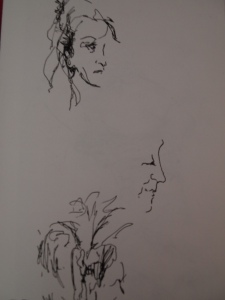A lot of ideas that I’ve been having recently all revolve around the perception of the ‘Artist’. For example, what makes someone Artistic? Is the Artist really embodied in a person, a living entity, or is Art (to clarify, the need to create Art) just based upon a feeling? Is it really justified to refer to any one individual as an ‘Artist’, whilst others are so unworthy of such attention?
We have five senses: the freedom to touch, taste, smell, hear and to see. The latter is perhaps the most significant when referring to our ‘perception’ of the Artist – or indeed, anyone at all. First impressions are often driven by aesthetics.
This is ultimately what continues to make visuals (and the Artist, who creates them) so important. Each painting, sculpture, film, advertisement is subject to the utopia that is seeing and looking and thinking. Concepts can often satisfy in the same way they can contort; indulging the shallowest and yet, the most intrinsic of all our senses. This sense of stature behind the Artist’s occupation makes it all the harder to portrait an honest depiction of ‘self’.
In referring to the conflicting elements of ‘Stature’ and ‘Self’, I refer to Rene Magritte’s iconic Self-Portrait, The Son of Man (see below).

Rene Magritte’s ‘Son of Man’ (1946)
The Apple
Magritte was famed for an ardent hatred of symbolism. He used them nonetheless. Within this self-portrait, the viewer is forced to identify with a rather strange focal point: The apple. Positioned directly in front of his face, it conceals all of his facial features. Instead, it may be said that the Apple symbolizes identity, as much as the common forms of eyes, nose and mouth may do within a typical portrait. It may also be interesting to note that this apple sits directly in line with the eyes. Eyes are known in Christianity as ‘windows to the soul’:
“When too late, Adam and Eve saw the folly of eating forbidden fruit.”
–Genesis, 3:6
The symbol of the Apple is appropriated from the biblical passage of Genesis. This quote describes Adam (Son of Man) and Eve (Daughter of Women) surrendering to temptation (their ‘folly’) by eating Apples from the Garden of Eden. Within christian context, the eating of this ‘forbidden fruit’ has been the source of all greed in humanity. In using this symbol, Magritte forces the viewer to overlook appearances, and to instead look upon the ‘formers’ of his inner self: his greed, and his vanity – characteristics which define us all.
The Suit & The Bowler Hat
“Well, so you have the apparent face, the apple, hiding the visible but hidden, the face of the person. It’s something that happens constantly. Everything we see hides another thing, we always want to see what is hidden by what we see. There is an interest in that which is hidden and which the visible does not show us. This interest can take the form of a quite intense feeling, a sort of conflict, one might say, between the visible that is hidden and the visible that is present.”
-Magritte on ‘Son of Man’
A contradiction of sorts, Magritte was the ‘anti-hero’ of the Surrealist movement. This is illustrated in his wearing of a suit: the conventional working man’s dress. Despite reaching critical acclaim at several points within his lifetime, Magritte believed that his talent for painting was of no great stature, saying: “Life obliges me to do something, so I paint.” Magritte refused to reduce himself to the aprons and overcoats worn by his artistic contemporaries in front of the canvas; once claiming that beginning a new painting was no different to starting a working day, and so he should present himself at his best at all times. The Bowler Hat acts as an accessory to this formal attire.
When questioning how the ‘Artist’ should be portrayed, it is important to see Magritte’s ‘Son of Man’ beyond its pleasing imagery. In spite of Magritte’s great gift for painting, he felt himself defined by the very sins in which we all, as members of the human race, are guilty of; Ordinary, in any measure, from the suits he wore to the professional manner in which he worked for his living.
‘The Artist’ is a person.




